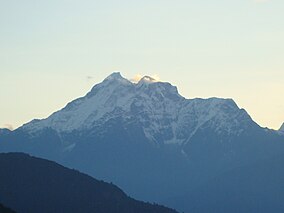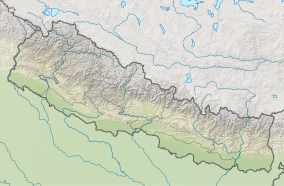Gaurishankar Conservation Area
| Gaurishankar Conservation Area | |
|---|---|
IUCN category VI (protected area with sustainable use of natural resources) | |
 View of Gaurishankar | |
| Location | Nepal |
| Coordinates | 27°52′N 86°11′E / 27.87°N 86.18°E |
| Area | 2,179 km2 (841 sq mi) |
| Established | 11 January 2010 |
| Governing body | Department of National Parks and Wildlife Conservation |

Gaurishankar Conservation Area is a protected area in the
History
In April 2006, the Dolakha Chamber of Commerce and Industries has requested the Government of Nepal and the Nepal Tourism Board to declare the Rolwaling area as a national park.[3]
In January 2010, the Federation of Community Forest Users, Nepal expressed its disagreement against the decision to establish a conservation area and formed a National Struggle Committee to launch a campaign against the declaration, demanding that the community people should obtain management responsibility of the protected area.[4]
Conservation Area Boundary
The Gaurishankar Conservation Area encompasses 22 VDCs, covering three districts. In
Flora and fauna
The Gaurishankar Conservation Area is rich in bio-diversity. A total of 16 varieties of vegetation have been identified in the area, including forests of Pinus roxburghii, Schima-Castanopsis, Alnus, Pinus wallichiana, Pinus patula, Rhododendron, Quercus lanata and Temperate mountain oak forest.[6]
Mammals
The Gaurishankar Conservation Area's mammalian population totals 34 species, including
In February 2019, anBirds
A total of 235 species of birds have been recorded from the Gaurishankar Conservation Area.[5]
Others
The conservation area also has 14 snake species, 16 species of fish, 10 types of amphibians and 8 lizard species.[citation needed]
Kalinchowk Bhagwati Shrine
There is a famous

See also
- Sun Kosi
- Sherpa people
References
- ^ World Wildlife Fund (2012). "Nepal REDD+ Readiness" (PDF). WWF Nepal. Archived (PDF) from the original on 2015-06-19. Retrieved 2015-06-19.
- ^ a b NTNC (2010). Gaurishankar Conservation Area Project Archived 2019-06-03 at the Wayback Machine. National Trust for Nature Conservation, Nepal.
- ^ ISBN 978-92-9115-033-5. Archived from the original(PDF) on 2011-07-26. Retrieved 2018-12-14.
- ^ Fecofun (2010) An update on FECOFON's Movement against Gaurishankar Conservation Area Declaration Archived 2012-03-25 at the Wayback Machine Federation of Community Forest Users, Nepal
- ^ a b c Department of National Parks and Wildlife Conservation (2014). "Gaurishankar Conservation Area". Government of Nepal. Archived from the original on 2014-09-11.
- ^ "Gaurishankar: New Conservation Area Under NTNC Management". National Trust for Nature Conservation. Archived from the original on 12 May 2013. Retrieved 22 February 2013.
- .

